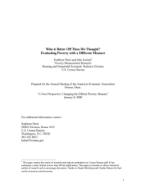Who is Better Off Than We Thought? Evaluating Poverty with a Different Measure
Who is Better Off Than We Thought? Evaluating Poverty with a Different Measure
Abstract
This paper describes and compares the poverty population under several different experimental measures of poverty by showing the prevalence of poverty using different measures and focusing on demographic and socioeconomic differentials across subgroups of the population. Results indicate that, while many groups are somewhat more likely to be classified as poor under the experimental measures, the depth of their poverty is less than is generally found under the official measure. Further, income-to-poverty threshold ratios reveal that for several groups, such as children, African Americans, and Hispanics, the percent in extreme poverty is lower under the experimental measures than the official measure.
A few elements in the experimental measures have a particularly important role in changing our perception of who is poor. For one, accounting for health care costs considerably increases the numbers of people who appear to be struggling to get by. Particularly, it increases the numbers of elderly who are perceived to be poor, while only slightly affecting the number of poor children and African Americans.
MOOP expenses tend to shift poverty rates up while not affecting, in most cases, the trend of poverty over time. However, over a longer period of time, important changes in health care costs, if accounted for accurately, could significantly affect our estimates of who is poor.
Equivalence scales matter for some groups. Where subgroups differ by family composition, equivalence scales can change our perception of the differential incidence of poverty. Geographic adjustments also matter, but need additional work to be properly constructed and applied.
Most important, however, we see that the current official measure of poverty is ‘improvable’. As has been shown by examining the different measures presented here, there is much to be learned from a poverty measure that is carefully and explicitly constructed. It allows us to understand more precisely the economic situation of families and individuals. Including government benefits aimed at the most needy in our measures also helps gauge the effectiveness of these programs in improving the lives of low income families and individuals and more carefully ascertain the situation of particular population subgroups that are often specifically targeted for aid. The new measures also capture the effects of tax policies, particularly beneficial programs such as the EITC. Finally, the new measures allow us to more thoroughly understand the costs and economic hardship that individuals and families face and to examine where and how difficulties arise.
Others in Series
Working Paper
Working Paper
Working Paper




